Some chicken pox scars dissolve with time, but the persistent ones remain and become permanent unless treated. If you have residual scarring from chicken pox, a chicken pox scar removal cream or other medical intervention can effectively smooth the skin.
There are many options available for removing chickenpox scars. The best approach to finding the perfect one for you is to consult with your dermatologist. Still, let's take a closer look at some therapy alternatives for chicken pox scars.
1. Retinol creams
Retinol, a strong vitamin A derivative, has been clinically demonstrated to increase collagen formation. Apply retinol cream to your scar every night before bed to encourage collagen production in a significantly low area. If you find it too much trouble, you can start with every other day. This Roc wrinkle cream has both retinol and glycolic acid.
2. Exfoliants
Exfoliating a scar may help in the removal of pigmented or tough skin. It can be mechanical or chemical.
Body and face scrubs, brushes, and other instruments are examples of mechanical exfoliants. Every three days, apply them straight on your scar in a circular motion.
Lotions that induce a minor chemical reaction to exfoliate the top layer of skin are known as chemical exfoliants. Apply these straight on your scar as often as the instructions specify.
3. Scar removal creams
Scar removal creams sold over the counter (OTC) contain a variety of chemicals that are thought to help prevent or minimize the appearance of scars. Despite the lack of clinical evidence, many people find them beneficial.
The product you select will be determined by the age of the scar. Check out this Mederma product, which is intended to cure both old and fresh scars.
4. Excision and punch excision
Scar excisions are a last resort when all other scar eradication methods have failed. Your doctor will use a scalpel or a punch instrument to remove the scar tissue while you are sedated surgically. They will then sew up the wound. This treatment is best suited for scars that are deep, pitted, and sunken. In addition, you will be exchanging a crater-like pockmark for a new, maybe cosmetically enhanced linear scar. This scar, however, will be permanent.
5. Fillers
Soft tissue fillers can be used to contour depressed or sunken scars. To decrease the appearance of a scar, soft tissue fillers such as hyaluronic acid and fat can be injected directly into it. These therapies are very temporary, lasting approximately six months.
6. Microneedling
Microneedling is a relatively recent process that involves the use of rolling-pin-like equipment covered in extremely small needles. After applying anesthesia to your face, your doctor will roll the tool back and forth with great force. There will be minor bleeding.
Microneedling increases collagen production, resulting in smoother-looking skin. The operation may need to be done numerous times. The results will not be available for several months.
7. Microdermabrasion
Microdermabrasion is a procedure that sands away the top layer of skin with a fast-revolving brush. It is less deep than dermabrasion, which penetrates deeper into the tissue and allows for skin remodeling. Both procedures are extremely effective in removing scars. Dermabrasion can eliminate surface scars completely and dramatically enhance the appearance of deep scars.
8. Chemical peels
Chemical peels are another method for resurfacing the skin's outer layer. A high concentration of acid is applied to the skin, eliminating the outer layer and enhancing the appearance of deep scars.
A mild peel can be performed swiftly and with no downtime at the doctor's office. A medium peel can also be performed at the doctor's office, but the healing time may be several weeks. Deep chemical peels are more dangerous operations that frequently necessitate anesthesia and months of recovery time.
You may need one gentle peel every week for several weeks to see improvements in your scars. Medium peels should be separated more widely.
You can also execute a chemical peel at home, albeit the results will be inferior to those of a professional peel.
9. Skin grafting
A skin graft is a surgical treatment used to treat severe and extensive scars caused by burns, surgeries, or other traumas. Skin grafts, on the other hand, can be utilized to improve the appearance of significant face scarring. A skin graft entails removing donor skin from another part of your body and putting it on the scar site.
10. Laser resurfacing
One of the most popular professional scar treatments is laser therapy. It can improve the appearance of depressed chickenpox scars and lighten the color of scars. There are two kinds of laser resurfacing: ablative and nonablative. The former is slightly more invasive than the latter.
Laser treatments may normally be performed as an outpatient procedure and do not require anesthesia.






Comments